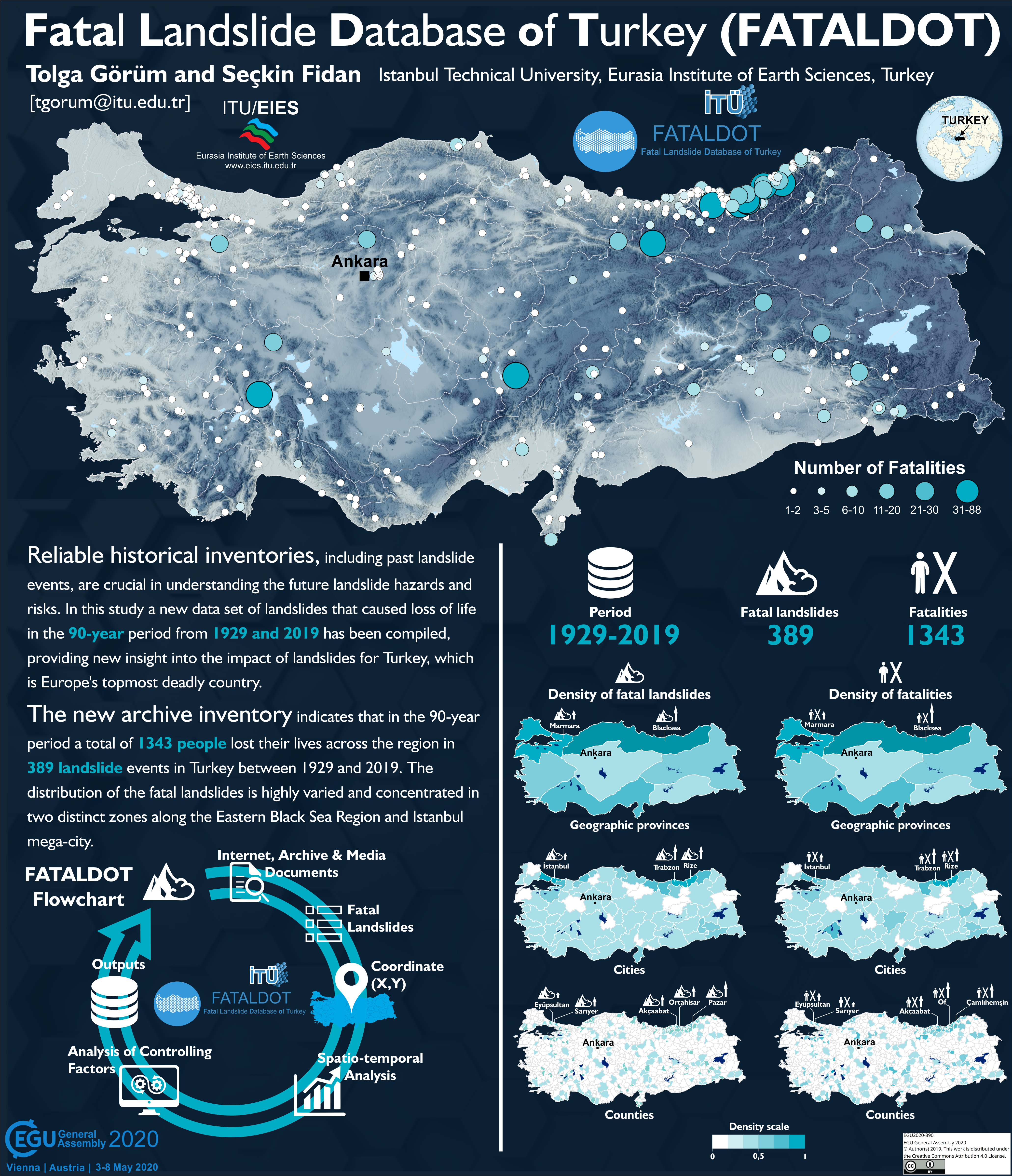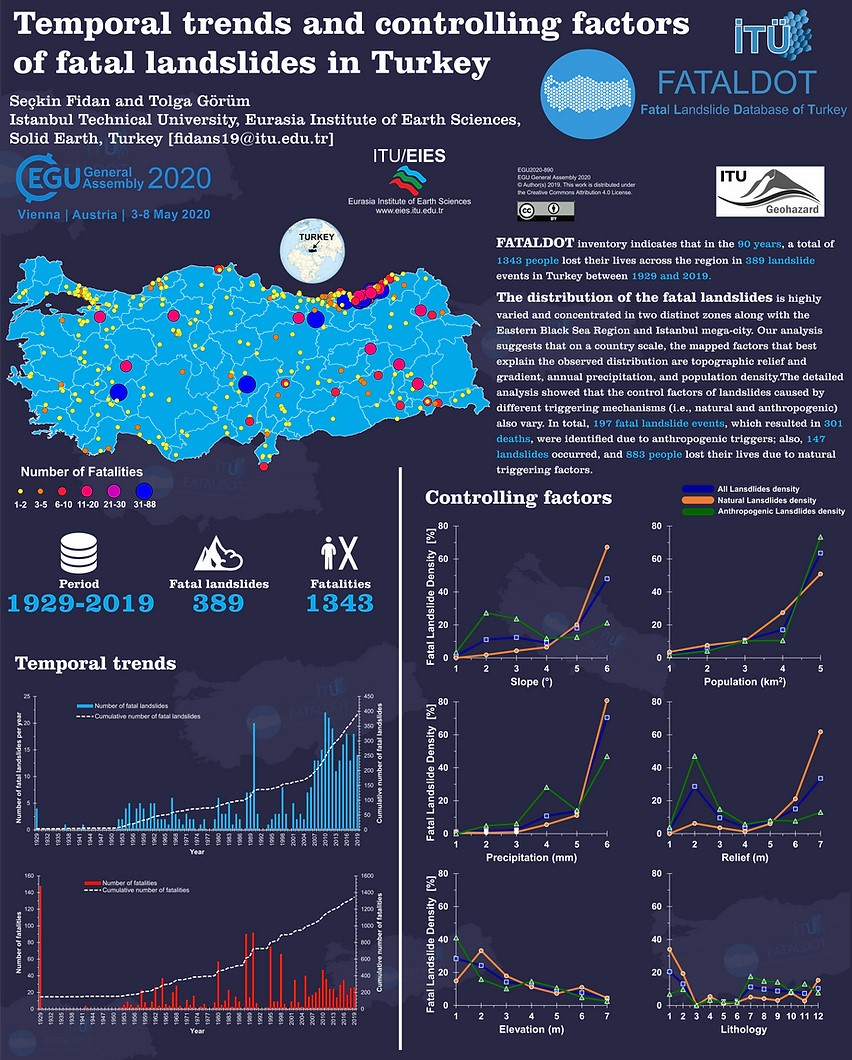Landslides are one of the destructive geomorphological hazards that cause substantial socioeconomic and environmental damages on a global scale. Knowing the precise number of deaths caused by landslides and their spatial and temporal distributions will facilitate a better understanding of the losses and damages, and further to prevent and minimize the damages caused by this type of disasters. Thus, reliable historical inventories, including past landslide events, are crucial in understanding the future landslide hazards and risks.
Annually, a large number of landslide events that resulted in the deaths of dozens of people occur in Turkey. However, the preparation of an inventory of fatal landslide events in Turkey has been neglected until today. In this respect, a database on fatal landslide events in Turkey for the period from 1929 to 2019 was compiled from various sources comprising national and local printed and digital media reports with pre-determined keywords in Turkish, academic papers, disaster, and city annual reports, and government and aid agency reports.
In this study a new data set of landslides that caused loss of life in the 90-year period from 1929 and 2019 has been compiled, providing new insight into the impact of landslides for Turkey, which is Europe's topmost deadly country. According to the new database, 1343 people lost their lives as a result of 389 landslide events in Turkey between 1929 and 2018. In total 197 fatal landslide events, which resulted in 301 deaths, were identified due to anthropogenic triggers (i.e., construction, infrastructure, and mining activities). On the other hand, 147 landslides occurred, and 883 people lost their lives due to natural triggering factors. The natural trigger origin of the fatal landslides is concentrated in the Eastern Black Sea and is generally shallow landslides corresponding to regolithic zones where chemical weathering is severe. On the contrary, the trigger factor of 45 landslide events cannot be assigned to the FATALDOT database due to a lack of detailed information in incidence reports.

The distribution of the fatal landslides is highly varied and concentrated in two distinct zones along the Eastern Black Sea Region and Istanbul mega-city. Our analysis suggests that on a country scale the mapped factors that best explain the observed distribution are topographic relief and gradient, annual precipitation and population density. Temporal trend analysis reveals a significant rise in the number of deadly landslides and hotspots across the studied period was observed.
The detailed analysis showed that the control factors of landslides caused by different triggering mechanisms (i.e., natural and anthropogenic) also vary. The landslides of natural trigger origin are concentrated in areas with high topographic relief and slope values, whereas those triggered by anthropogenic factors are concentrated in areas with low topographic relief and slope values. While the slope values were 10.5° in the areas where all the fatal landslides occurred, these values were 14.5° for natural landslides and 8° for anthropogenic landslides. In the areas where landslides triggered by natural factors, the average topographic relief is approximately 600 meters higher than the landslides of anthropogenic origin. Moreover, we observed that fatal landslides have not triggered during the seasonal rainy period, but rather caused by sudden and heavy torrential rainfall during the summer period when the average annual rainfall is low. Fatal landslides triggered by natural factors are concentrated in the Eastern Black Sea section and occur on the Upper Cretaceous and Lower-Middle Eocene volcanics classified as median volcanic rocks with an average thickness of ten meters. The landslides on these lithological units are shallow landslides, which occur mainly a few meters above the regolithic zone, where chemical weathering is severe in this area. Fatal landslides of anthropogenic origin occur in urban and metropolitan centers where human activity is high due to infrastructure and construction works, and they are predominantly corresponding with areas where the topographic relief difference is low.

Highlights
- FATALDOT inventory indicates that in the 90 years, a total of 1343 people lost their lives across the region in 389 landslide events in Turkey between 1929 and 2019.
- These landslide events, which show intensity in the summer during the year, constitute two major density regions, the Eastern Black Sea Region and the Istanbul environment.
- In general, the Eastern Black Sea Region is represented by fatal landslides triggered by natural factors, while fatal landslides triggered by anthropogenic factors characterize the Istanbul and near vicinity.
- We observed that fatal landslides have not triggered during the seasonal rainy period, but rather caused by sudden and heavy torrential rainfall during the summer period when the average annual rainfall is low.
- The database, which is planned to be transformed into an information system with a semi-automatic update feature is thought to be an underlying data source for future research works to prevent hazard and risk studies and landslide-related deaths in the country scale.
Publications related to this research:
Fidan, S., Gorum, T., Spatial and Temporal Distribution of Fatal Landslides in Turkey (1929-2019) (To be submitted to the Landslides).
Fidan, S. ve Görüm, T. (2020). Türkiye’de ölümcül heyelanların dağılım karakteristikleri ve ulusal ölçekte öncelikli alanların belirlenmesi. Türk Coğrafya Dergisi (74), 123-134. DOI:10.17211/tcd.731596
Abstracts and presentations related to this research:
Gorum, T., Fidan, S., (2020). Fatal Landslide Database of Turkey (FATALDOT). In EGU 2020 General Assembly Conference Abstracts, Vienna.
Fidan, S., Gorum, T., (2020). Temporal trends and controlling factors of fatal landslides in Turkey. In EGU 2020 General Assembly Conference Abstracts, Vienna.
Fidan, S., Gorum, T., “The Role of Topographic and Climatic Factors on the Distribution of Fatal Landslides in Turkey”, International Symposium on Geomorphology, ANKARA, TURKEY, 10-12 October 2019, pp. 92-93
Fidan, S., Gorum, T., “Fatal Landslide Archive Inventory of Turkey from 1929 to 2018”, International Disaster & Resilience Congress (IDRC), ESKİŞEHİR, TURKEY, 26-29 June 2019, pp. 1109-1110
Fidan, S., Gorum, T., “Spatial and Temporal Distribution of Fatal Landslides in Turkey From 1929 to 2018”, 1st Istanbul International Geography Congress, ISTANBUL, TURKEY, 20-22 June 2019, pp. 10-11